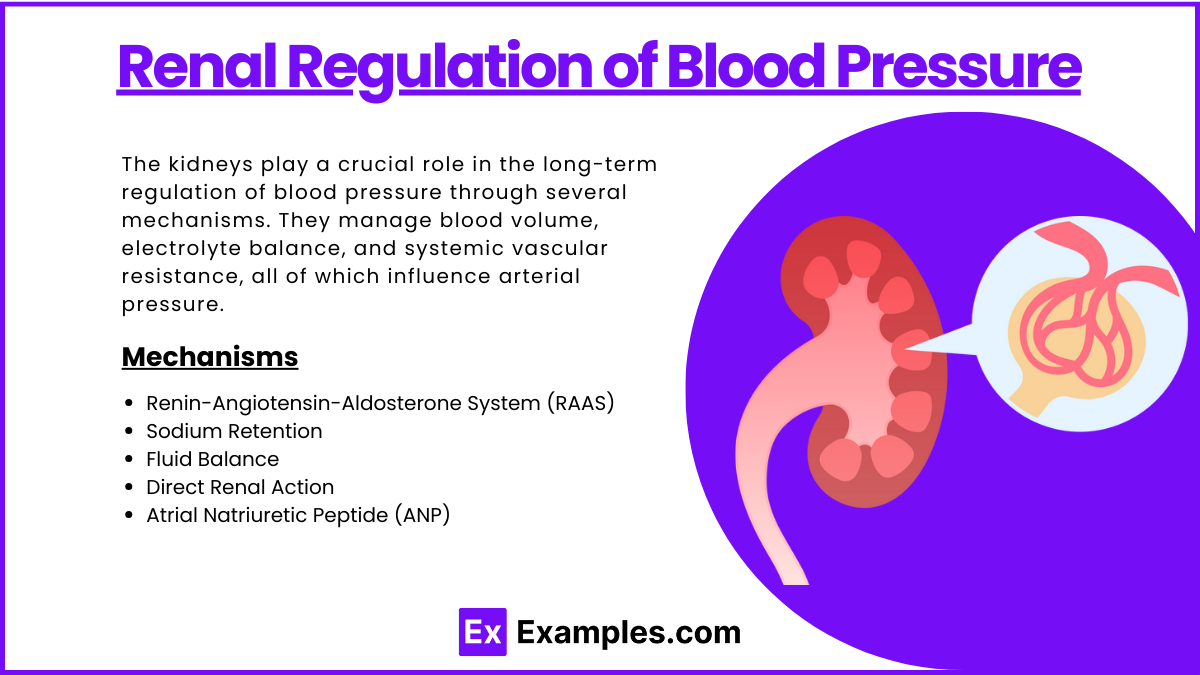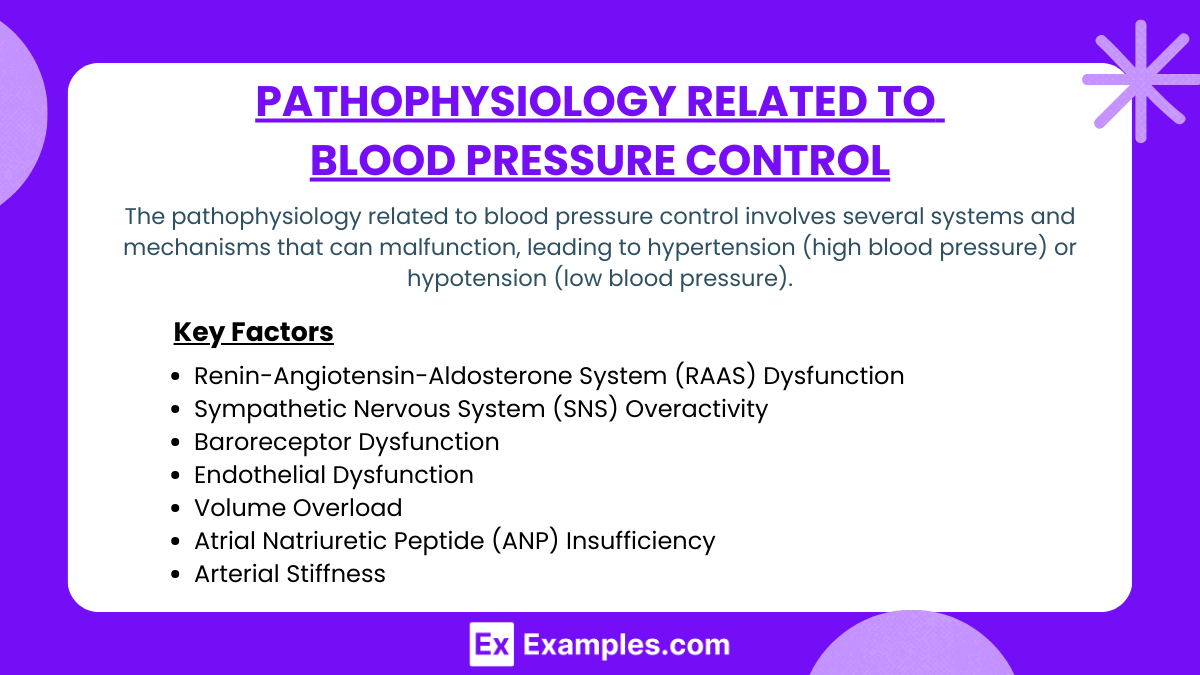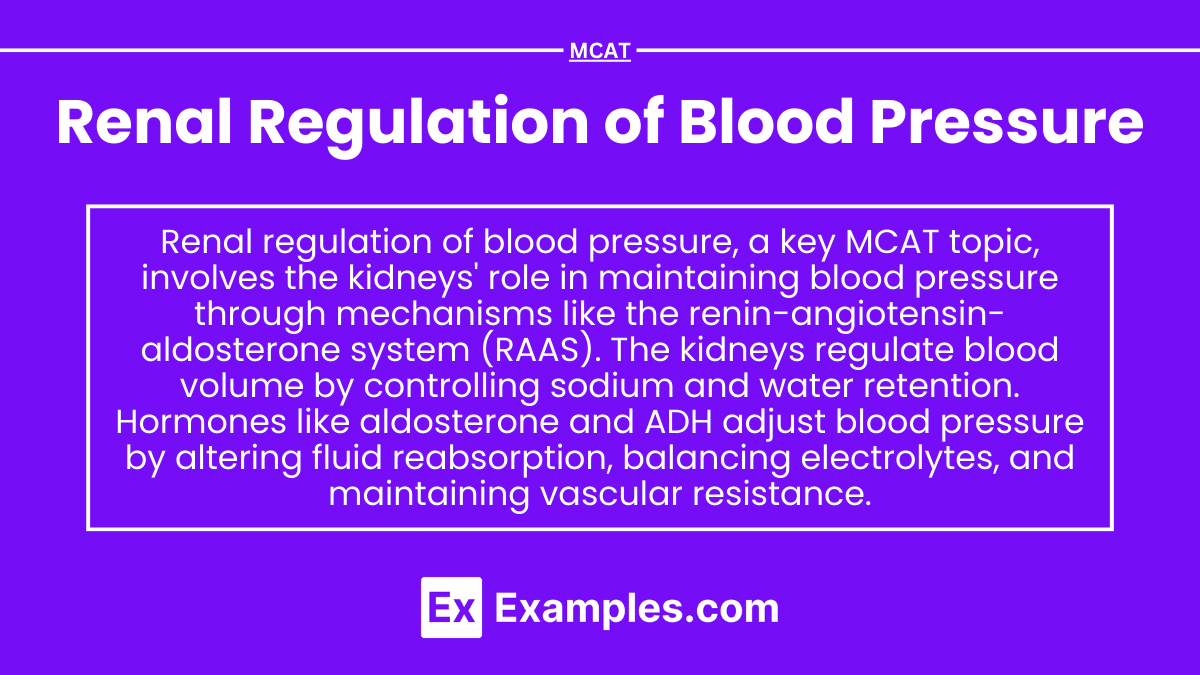Preparing for the MCAT requires a thorough understanding of renal regulation of blood pressure, a fundamental aspect of the Organ Systems foundation. Mastery of kidney functions, including control of fluid balance, electrolyte levels, and renin secretion, provides critical insights into cardiovascular stability and is essential for achieving a high MCAT score.
Learning Objective
In studying “Renal Regulation of Blood Pressure” for the MCAT, you should aim to understand how the kidneys control systemic blood pressure. Learn the roles of the renin-angiotensin-aldosterone system (RAAS), natriuretic peptides, and the regulation of body fluid osmolarity and volume. Explore how alterations in kidney function, such as changes in sodium and water reabsorption, affect blood pressure. Additionally, analyze the impact of hypertension on renal function and the kidney’s adaptive mechanisms to pathological states. Apply this knowledge to solve MCAT practice questions that test your ability to integrate and apply complex concepts of renal physiology and pathology.
Understanding Renal Regulation of Blood Pressure

The kidneys play a crucial role in the long-term regulation of blood pressure through several mechanisms. They manage blood volume, electrolyte balance, and systemic vascular resistance, all of which influence arterial pressure. Here’s how renal regulation of blood pressure works:
1. Renin-Angiotensin-Aldosterone System (RAAS)
One of the primary ways the kidneys regulate blood pressure is through the RAAS:
- Renin: Produced by specialized cells in the kidneys (juxtaglomerular cells) when blood flow to the kidneys decreases, blood pressure drops, or there is a low sodium concentration in the urine. Renin converts angiotensinogen (released by the liver) into angiotensin I.
- Angiotensin-Converting Enzyme (ACE): Located primarily in the lungs, ACE converts angiotensin I into angiotensin II.
- Angiotensin II: A potent vasoconstrictor that narrows blood vessels, increasing systemic vascular resistance and blood pressure. It also stimulates the secretion of aldosterone from the adrenal cortex and antidiuretic hormone (ADH) from the pituitary gland, which together enhance fluid retention, thereby increasing blood volume and pressure.
2. Sodium Retention
- Aldosterone: Promoted by angiotensin II, aldosterone causes the kidneys to retain sodium. Water follows sodium, increasing blood volume and pressure.
- Tubuloglomerular Feedback: This mechanism involves the detection of sodium chloride concentrations in the fluid in the distal tubule of the nephron. If sodium levels are low, it suggests low blood volume and pressure, triggering renin release to increase both.
3. Fluid Balance
- Antidiuretic Hormone (ADH): While primarily involved in water retention, ADH can also affect blood pressure by increasing water reabsorption in the kidneys, which increases blood volume.
4. Direct Renal Action
- Pressure Diuresis and Natriuresis: When blood pressure is high, the kidneys can help lower it by excreting more water and sodium. This reduces blood volume and pressure—a direct feedback mechanism independent of hormones.
5. Atrial Natriuretic Peptide (ANP)
- ANP: Released from the heart when atrial pressure increases, ANP complements renal efforts by promoting sodium and water excretion, which helps lower blood volume and pressure. ANP also inhibits the RAAS.
Pathophysiology Related to Blood Pressure Control

The pathophysiology related to blood pressure control involves several systems and mechanisms that can malfunction, leading to hypertension (high blood pressure) or hypotension (low blood pressure). Understanding these disturbances is crucial for diagnosing and managing blood pressure-related disorders effectively. Here’s an overview:
1. Renin-Angiotensin-Aldosterone System (RAAS) Dysfunction
- Hypertension: Overactivity of the RAAS can lead to excessive vasoconstriction and fluid retention, increasing blood pressure. Conditions such as renal artery stenosis can trigger increased renin release, exacerbating this effect.
- Hypotension: Insufficient RAAS activity may occur due to adrenal insufficiency (e.g., Addison’s disease) where aldosterone levels are inadequate, leading to decreased sodium and water retention and lower blood pressure.
2. Sympathetic Nervous System (SNS) Overactivity
- Hypertension: Enhanced sympathetic activity can increase heart rate and contractility, and cause widespread vasoconstriction, all of which elevate blood pressure. Chronic stress, obesity, and certain genetic factors can predispose individuals to increased SNS activity.
3. Baroreceptor Dysfunction
- Hypotension or labile blood pressure: Baroreceptors in the carotid sinus and aortic arch are responsible for sensing changes in blood pressure and adjusting it through the SNS and parasympathetic nervous system. If these receptors or their neural pathways are damaged (as in aging or diabetes), blood pressure control becomes erratic and less responsive to postural changes or stress.
4. Endothelial Dysfunction
- Hypertension: The endothelium (lining of blood vessels) plays a key role in modulating vascular tone by releasing substances like nitric oxide (NO), which promotes vasodilation. If the endothelium is damaged (due to factors like high cholesterol, smoking, or high blood pressure), its ability to produce NO decreases, leading to increased vascular resistance and hypertension.
5. Volume Overload
- Hypertension: Excessive fluid in the circulatory system, whether from kidney disease, heart failure, or excessive salt intake, can raise blood pressure by increasing cardiac output and venous return.
6. Atrial Natriuretic Peptide (ANP) Insufficiency
- Hypertension: ANP helps to reduce blood volume and promote vasodilation. A deficiency in ANP or resistance to its effects can contribute to hypertension.
7. Arterial Stiffness
- Hypertension: Increased stiffness of large arteries as a result of aging or atherosclerosis can impair the buffering of systolic blood pressure, leading to increased pulse pressure and systolic hypertension.
Examples
Example 1: Activation of RAAS Due to Decreased Renal Perfusion
- Scenario: A patient experiences dehydration from prolonged vomiting.
- Process: Dehydration leads to decreased blood volume and blood pressure, reducing renal perfusion. This triggers the kidneys to release renin, initiating the renin-angiotensin-aldosterone system (RAAS), which increases blood pressure by vasoconstriction and sodium and water retention.
Example 2: Effect of ACE Inhibitors on Blood Pressure
- Scenario: A patient with hypertension is prescribed an ACE inhibitor.
- Process: ACE inhibitors block the conversion of angiotensin I to angiotensin II, reducing its vasoconstrictive effects and decreasing aldosterone secretion. This leads to lower blood volume and pressure by decreasing sodium and water reabsorption in the kidneys.
Example 3: Natriuretic Peptides in Response to Fluid Overload
- Scenario: A patient with heart failure experiences fluid overload.
- Process: The increase in blood volume stretches the heart’s atria, leading to the release of atrial natriuretic peptide (ANP). ANP acts on the kidneys to promote excretion of sodium and water, reducing blood volume and pressure, and alleviating the heart’s workload.
Example 4: Chronic Kidney Disease and Hypertension
- Scenario: A patient with chronic kidney disease develops hypertension.
- Process: Damage to the kidneys’ nephrons impairs their ability to excrete sodium adequately, leading to volume overload and increased systemic blood pressure. Chronic kidney disease also often results in elevated renin levels, further contributing to hypertension.
Example 5: Secondary Hyperaldosteronism and Renal Artery Stenosis
- Scenario: A patient presents with severe hypertension and is diagnosed with renal artery stenosis.
- Process: The narrowing of the renal artery reduces blood flow to one kidney, which perceives this as low blood volume, triggering excessive renin release. This causes increased levels of angiotensin II and aldosterone, leading to hypertension by heightened sodium and water retention.
Practice Questions
Question 1: Role of Angiotensin II
What is the primary action of angiotensin II in the regulation of blood pressure?
A) Decreases sodium reabsorption in the kidneys
B) Causes vasodilation of peripheral blood vessels
C) Causes vasoconstriction of peripheral blood vessels
D) Decreases blood volume
Correct Answer: C) Causes vasoconstriction of peripheral blood vessels
Explanation:
Angiotensin II is a potent vasoconstrictor, which means it causes the blood vessels to constrict (narrow). This increases the resistance in the blood vessels, leading to an increase in systemic blood pressure. Angiotensin II also promotes sodium and water retention indirectly through the release of aldosterone, further increasing blood pressure, but its direct effect on vasoconstriction is a critical mechanism for acute regulation of blood pressure.
Question 2: Effects of Aldosterone
What does aldosterone primarily regulate?
A) Potassium excretion and sodium reabsorption
B) Calcium reabsorption
C) Excretion of bicarbonate
D) Absorption of glucose
Correct Answer: A) Potassium excretion and sodium reabsorption
Explanation:
Aldosterone, a steroid hormone secreted by the adrenal cortex, plays a crucial role in the regulation of blood pressure by increasing the reabsorption of sodium and the excretion of potassium in the distal convoluted tubules and collecting ducts of the nephron. By increasing sodium reabsorption, aldosterone also enhances water retention, which increases blood volume and pressure.
Question 3: Impact of ACE Inhibitors on Blood Pressure
How do ACE inhibitors help to lower blood pressure?
A) They increase levels of angiotensin II.
B) They promote sodium retention.
C) They block the conversion of angiotensin I to angiotensin II.
D) They stimulate the release of aldosterone.
Correct Answer: C) They block the conversion of angiotensin I to angiotensin II.
Explanation:
ACE inhibitors, such as lisinopril or enalapril, are used to treat hypertension primarily by inhibiting the enzyme angiotensin-converting enzyme (ACE). This action blocks the conversion of angiotensin I to angiotensin II, a potent vasoconstrictor, thereby reducing blood pressure. Lower levels of angiotensin II also result in reduced secretion of aldosterone, decreasing sodium and water retention and further contributing to the reduction in blood pressure.


